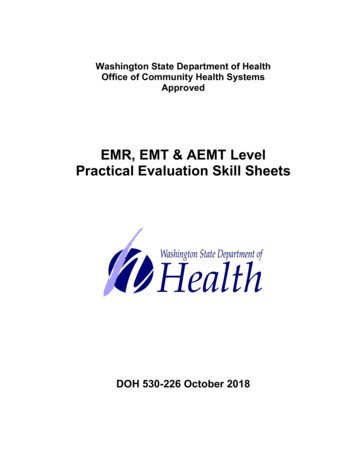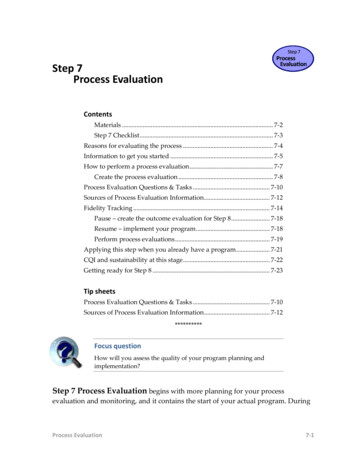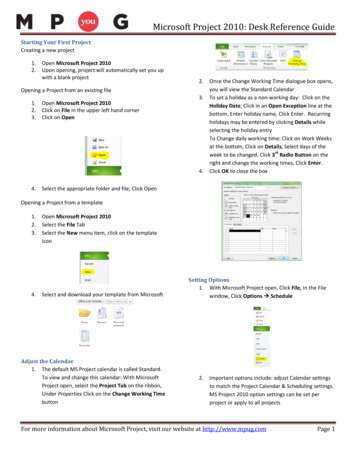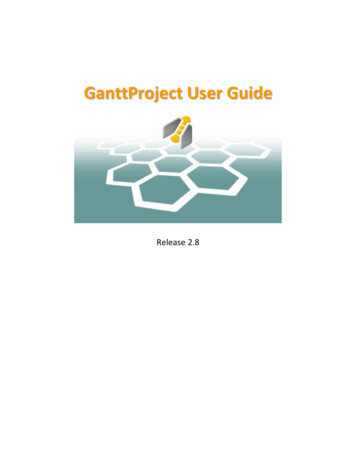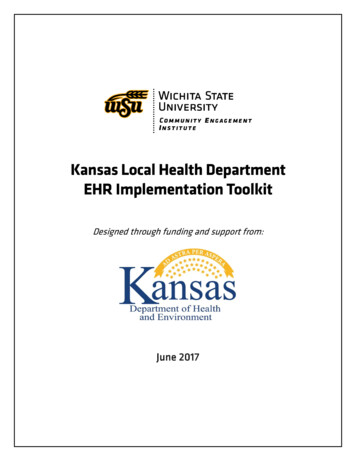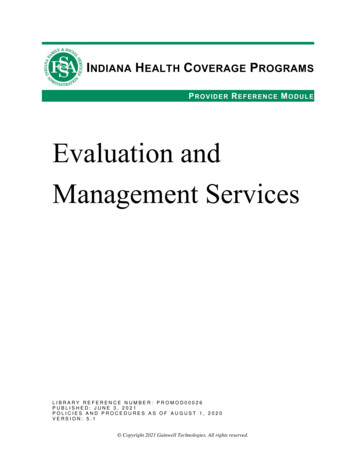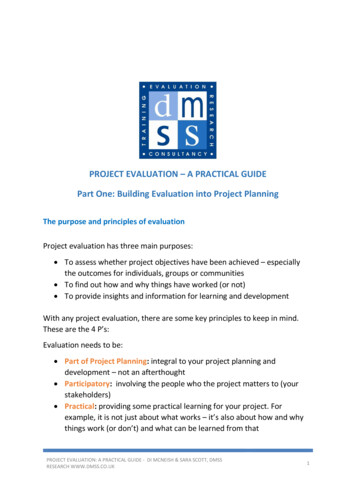
Transcription
PROJECT EVALUATION – A PRACTICAL GUIDEPart One: Building Evaluation into Project PlanningThe purpose and principles of evaluationProject evaluation has three main purposes: To assess whether project objectives have been achieved – especiallythe outcomes for individuals, groups or communities To find out how and why things have worked (or not) To provide insights and information for learning and developmentWith any project evaluation, there are some key principles to keep in mind.These are the 4 P’s:Evaluation needs to be: Part of Project Planning: integral to your project planning anddevelopment – not an afterthought Participatory: involving the people who the project matters to (yourstakeholders) Practical: providing some practical learning for your project. Forexample, it is not just about what works – it’s also about how and whythings work (or don’t) and what can be learned from thatPROJECT EVALUATION: A PRACTICAL GUIDE - DI MCNEISH & SARA SCOTT, DMSSRESEARCH WWW.DMSS.CO.UK1
Proportionate: the scale of your evaluation needs to fit with the scale ofyour project. You shouldn’t spend more time evaluating than doing!Six steps to evaluation and learningThis chapter provides a framework for building evaluation into projectplanning. It draws on a number of models, in particular, theory of change1andrealistic evaluation.2The framework is based around 6 steps:1. Clarifying your current position and your ultimate goal: This involvesasking where are we now and where do we want to be? What are theissues we are seeking to address? What are the big changes we want tomake through our project?2. Setting out the outcomes you want to achieve: This involves askingwhat will be different for the people we work with if we are successful?What other changes will be seen?3. Planning the activities needed to achieve your outcomes: Thisinvolves asking, what will we need to do to achieve changes? Whatactivities/services will we provide and why do we think they will work?4. Setting out some milestones: This involves asking, how will we knowwe’re on track? What will be achieved in 12 months and 2 years and 3years’ time?5. Planning what evidence you will collect: This involves asking, how willwe know we’re reaching our milestones/outcomes and show otherswe’ve reached them? What are our indicators of success?6. Building in time and processes for reflection and learning: Thisinvolves asking, how will we learn from our project’s journey? How willwe share our learning with others?1Connell JP, Kubisch AC, Schorr LB, Weiss CH, eds. New Approaches to Evaluating CommunityInitiatives: Concepts, Methods & Contexts. Washington DC: The Aspen Institute 19952Pawson R, Tilley N. Realistic Evaluation. London: Sage Publications, 1997PROJECT EVALUATION: A PRACTICAL GUIDE - DI MCNEISH & SARA SCOTT, DMSSRESEARCH WWW.DMSS.CO.UK2
These 6 steps do not always happen in order. However, all the steps need to beconsidered and if you are planning something from scratch with a clean sheet,then it might be helpful to follow the steps from 1 to 6. In the real world ‘cleansheets’ are quite rare, so the order in which you consider the steps will dependon what has already happened and what can and cannot be changed. As yourproject develops, things will change and you will certainly want to re-visit thesteps in this framework. However, even some retrospective planning can beuseful, so if you find yourself plummeted into activity without a clear idea ofwhat you are hoping to achieve, but with an instruction to evaluate yourefforts, then this framework is still for you!STEP 1: Where are you now and where do you want to be?This step involves analysing the current position in terms of the needs orproblems your project has been set up to address – but not forgetting thestrengths and assets which also exist. At the same time, it involves defining theultimate goal of your project. These two tasks have been merged into one stepbecause they are inextricably linked: there’s no point setting a goal withoutreference to the current position; at the same time, analysis of the currentposition needs to be in relation to the ultimate goal of the project. In otherwords: when setting out on a journey, we need to know both where we arenow and where we want to go.Clarifying the current positionPROJECT EVALUATION: A PRACTICAL GUIDE - DI MCNEISH & SARA SCOTT, DMSSRESEARCH WWW.DMSS.CO.UK3
This means analysing the problem or need which your project is aiming toaddress. In carrying out this analysis, the following questions may be helpful: What is the need or problem?Why do we think it exists?Whose need or problem is it (what is our target group or area)?What are the strengths and assets which can be drawn on?What evidence is there to support our analysis? (e.g. research carriedout in the area or elsewhere, consultations, local statistics) Who else has an interest in this need or problem-who are the otherstakeholders (e.g. are there other projects or services working in thisfield, are there service user groups with an interest) Is our analysis shared by these other stakeholders? (e.g. do the womenand girls you plan to work with agree with your analysis of their needs) What evidence is available that helps describe our starting point (e.g. isthere any information which can be used as a ‘baseline’ for the project?)Key points A lot of information about needs, problems, strengths and assets is inpeople’s heads – to be of any use for evaluation it has to be drawn outand written down. There are many myths about the needs and problems of particulargroups and communities. It is important to ensure that your analysis ofthe current position is supported by the evidence, not just impressionand anecdote. Needs and problems are generally defined by those stakeholders withmost power and influence. Organisations providing services usually havemore influence on the definition of need than those who are deemed tohave the need. In setting out your current position it is important to beclear about whose need / problem is being analysed and who has had asay in defining it. Traditionally, health and welfare services have been based on a ‘deficitmodel’ which focusses more on what is wrong with individuals, familiesand communities than what is right about them. An analysis of thecurrent position must include the strengths and resources which exist aswell as the needs and problems.PROJECT EVALUATION: A PRACTICAL GUIDE - DI MCNEISH & SARA SCOTT, DMSSRESEARCH WWW.DMSS.CO.UK4
Setting out your Ultimate GoalThis needs to be expressed as a short, clear statement of intent which can bereadily understood by all stakeholders. It should capture the project’s vision forchange.Key Points The goal is intended to be an overarching statement of intent – it shouldbe kept short and simple. Avoid qualifying words and phrases such as ‘where possible’ or ‘asappropriate’. These are expressions that are often used to minimiseexpectations but which are really quite meaningless. The ultimate goal needs to be understood and shared by all the keystakeholders of your project. This requires a participatory process andclear communication. If it is formulated by a few managers andconcealed in a strategy document nobody reads, it is virtually useless. The goal should be aspirational and inspiration but not laughable – itneeds to be located in the real world.Example: The Obinrin Project for migrant womenHere is a fictional example of a new project being set up for migrant women.The group of women setting up the project got together to analyse the currentposition. They knew it was important to be clear about the needs they wereaiming to meet, and they also wanted to be able to communicate these needsto others – particularly potential funders. They decided to carry out a simpleneeds analysis and split tasks between them in order to:- Obtain local authority statistics about migrant women in the area. Theyalso asked local schools and housing associations about the number ofmigrant families they were aware of- They called a meeting of local workers to discuss the needs of migrantwomen in the area – they invited GPs, health visitors, CAB adviceworkers to come and share their knowledge- They consulted with migrant women by starting with the women theyalready knew and getting them to bring others to small discussiongroupsPROJECT EVALUATION: A PRACTICAL GUIDE - DI MCNEISH & SARA SCOTT, DMSSRESEARCH WWW.DMSS.CO.UK5
From their needs analysis, they concluded that the main issues for migrantwomen were poverty and poor employment opportunities. Thesedifficulties were compounded by social isolation and lack of access tofinancial support and advice. There were lots of other issues in migrantwomen’s lives – but the poverty and financial exclusion was the one thatseemed to limit their choices the most.They therefore decided that the vision for their project was for migrantwomen to have the financial security and the social support to live the livesthey want to live.STEP 2: What will be different when we get there?This step involves setting out the long-term outcomes which you are seekingto achieve and agreeing a timescale by which they can realistically be achieved.Outcomes are the results you hope to see. They need to be focused onchanges in people’s lives e.g. in their health and well-being - not just changesin the way services are delivered.PROJECT EVALUATION: A PRACTICAL GUIDE - DI MCNEISH & SARA SCOTT, DMSSRESEARCH WWW.DMSS.CO.UK6
Setting out the long-term outcomes involves asking yourselves and yourstakeholders the following questions: If we were to be successful in bringing about positive change, whatwould be different for the people or communities we identified in Step1? When do we realistically believe we can achieve these changes? Can we state these changes in terms of clear outcomes? Would these be understood and shared as being the most importantones by all stakeholders?Key points One of the most common mistakes when setting outcomes is to expressthem in terms of changes to the way services are delivered or organised.Although these may be important they are only a means by which betteroutcomes for people may be achieved. Long-term outcomes need to beoutcomes for people. Setting a realistic timescale is important. If you believe that achievingmeaningful change will take 10 years that needs to be made explicit –PROJECT EVALUATION: A PRACTICAL GUIDE - DI MCNEISH & SARA SCOTT, DMSSRESEARCH WWW.DMSS.CO.UK7
even if your project only has two years funding. Pretending you canachieve in two years what will realistically take ten, is doing nobody anyfavours. Outcomes should be clearly linked to the project’s ultimate goal.Example: The Obinrin Project for migrant womenThe Obinrin project’s ultimate goal was for migrant women to be able to livethe lives they want to live, with financial security and social support central tothis. The project identified 5 main outcomes they needed to achieve if this goalwas to be met. Four of these were for the women themselves – but one wasfor local employers who the project identified as critical stakeholders that theyneeded to get on board.STEP 3: What will we need to do to get there?This involves planning the activities which you believe will be required to bringabout your intended outcomes. This is an important step in assessing whetherwhat you plan to do is likely to contribute to the outcomes you have set. This iswhere your theory of change really comes in: the activities you identify shouldPROJECT EVALUATION: A PRACTICAL GUIDE - DI MCNEISH & SARA SCOTT, DMSSRESEARCH WWW.DMSS.CO.UK8
come from your theory of what needs to happen to achieve the changes youare seeking.This step involves asking the following questions: What do we need to do to achieve our outcomes? Why do we believe these activities/models/interventions will work inour particular context (‘what is our theory of change’)? Have they been tried before nationally or locally? What evidence do we have for their effectiveness? Are these activities likely to be acceptable and welcomed by those whoare going to be ‘on the receiving end’?Key Points Although planning activities is step 3 in this framework, in reality it isoften the first thing that is planned. Frequently, service providers andfunders have committed themselves to developing a particular kind ofservice before carrying out a systemic analysis of need and often withoutan explicit set of outcomes they are trying to achieve. This is not ideal! Activities need to be clearly directed at achieving your outcomes. If it’snot clear how an activity will contribute to an outcome it would beappropriate to question whether you should be doing it at all.PROJECT EVALUATION: A PRACTICAL GUIDE - DI MCNEISH & SARA SCOTT, DMSSRESEARCH WWW.DMSS.CO.UK9
In planning activities it makes sense to use the available evidence forwhat works. Many interventions to improve people’s well-being are notevidence-based. This may be because existing evidence is not routinelyused by planners, or because reliable evidence of effectiveness does notexist, or the available evidence is not applicable to the local context. Where the evidence for a planned intervention is uncertain, it isparticularly important to build in a means of evaluating its effects. Activities are frequently planned by service providers with relativelylittle input by those likely to be on the receiving end. People who usefacilities and services have expertise which needs to be central inplanning and designing projects.The Obinrin project exampleThe women setting up the Obinrin project had lots of ideas about things theycould potentially do – but they also wanted to do those things that would bemost effective with their limited resources. There was some discussion aboutwhether they should be providing language classes given that there was a localcollege teaching ESL courses. However, migrant women told them how theyhad struggled with these classes where there were many men and only a fewwomen. Some women had very traumatic histories and struggled toconcentrate – their particular learning support needs were not being met inthe college context.Another area which was much debated was how to engage employers. Again,it was women themselves that felt that by cooking a lunch they could bothdemonstrate their talents and create an opportunity to meet employersinformally and on their own terms. The project realised that this was an‘untested’ approach to employer engagement so were very interested inevaluating the impact of the lunches.PROJECT EVALUATION: A PRACTICAL GUIDE - DI MCNEISH & SARA SCOTT, DMSSRESEARCH WWW.DMSS.CO.UK10
Example: The Obinrin Project for migrant womenSTEP 4: What milestones will we need to reach at each stage of the journey?This step involves setting out the interim outcomes which you expect to haveachieved at intervals on your journey towards your ultimate goal. These mightinclude some ‘early wins’ – things which can be achieved in the shorter term.PROJECT EVALUATION: A PRACTICAL GUIDE - DI MCNEISH & SARA SCOTT, DMSSRESEARCH WWW.DMSS.CO.UK11
Setting milestones involves asking the following questions: If we are to achieve the long-term outcomes we identified at Step 2,what will we need to have achieved at some intermediate points on ourjourney? At what time points is it important and reasonable to have milestones inplace? Do they fit with your reporting requirements? E.g. to produce anannual report. Do these milestones make sense to key stakeholders?Key Points While long-term outcomes should represent improvements in the livespeople or communities, milestones are more likely to be a mixture ofpeople-focused changes and service-focused changes. E.g. they mightinclude things the project has to have in place, such as staff or training,in order to deliver its activities. It is important to be clear about timescales for achieving milestones. Ifyou have set your long-term outcomes to be achieved by year 5, youneed to be clear what milestones you will need to achieve by year 4, byyear 2, by year 1.PROJECT EVALUATION: A PRACTICAL GUIDE - DI MCNEISH & SARA SCOTT, DMSSRESEARCH WWW.DMSS.CO.UK12
Establishing milestones is particularly important if your project is shortterm funded and you hope to use evaluation to support further fundingbids. You should be able to demonstrate that you have achieved yourplanned outcomes for the first two years and are therefore on target toachieve long-term outcomes if funding is continued.Example: The Obinrin Project for migrant womenThe project gained funding for three years but needs to provide a report onprogress after 18 months. They decided that the milestones below couldreasonably be achieved in this period and would provide a good indication thatthey were on track to achieve their long-term outcomes.PROJECT EVALUATION: A PRACTICAL GUIDE - DI MCNEISH & SARA SCOTT, DMSSRESEARCH WWW.DMSS.CO.UK13
STEP 5 – How will we know when we’ve reached our outcomes and how canwe show others that we’ve reached them?This step involves setting out evidence you will need to assess whether or notyou are achieving your outcomes:Identifying the evidence you need involves asking the following questions: How will we know whether we are achieving our outcomes? What will be different at each stage of our journey if we’re beingsuccessful? What will show that we have done the things we said we’d do? Who is our target audience for this evidence? What will they be mostinterested in knowing? What quantitative evidence might there be to demonstrateachievement? What qualitative evidence might there be to demonstrate achievement? How will we build the collection of this evidence into our planning? How can we involve all the key stakeholders in collecting this evidence? What tools might be most appropriate for collecting this evidence? What do we need to be doing now to ensure that we have systems forcollecting this evidence?PROJECT EVALUATION: A PRACTICAL GUIDE - DI MCNEISH & SARA SCOTT, DMSSRESEARCH WWW.DMSS.CO.UK14
Key points Some evidence is easier to collect than others. This can make it temptingto collect what is ‘collectable’ regardless of how useful it might be. In attempting to demonstrate a link between interventions andoutcomes some kinds of evidence will be more convincing than others.Good evaluation uses the best possible evidence available in thecircumstances and is honest about what it can and cannot prove. Systems for collecting evidence should complement the practice of theproject rather than being an additional burden. What recording systemsalready exist and can any of these also be used for evaluation purposes? There is a variety of methods and tools which can be used to collectevaluative information. Which you use will depend on the sort ofinformation you are trying to collect and from whom. Questionnaires arenot the only option!Example: The Obinrin Project for migrant womenMilestonesEvidenceThe language skills of project usersare increasedAssessment of language skillsadministered by the teacher at thestart of courses and then every term.Women know how to look for jobsWomen’s self-report. Number ofapplications submitted andinterviews achieved.Local employers are engaging withNumber of work experiencethe project and offering workplacements offered. Numbersexperienceattending employers’ lunches.Feedback from employers – surveyconducted.Women have increased knowledgeFinancial review of individual s atand confidence in managing theirbaseline and changes in a) numbersfinances and are avoiding or reducing receiving benefit entitlement b)debtsreductions in debt/borrowing. Casestudies in which women describe thechanges for themselves.PROJECT EVALUATION: A PRACTICAL GUIDE - DI MCNEISH & SARA SCOTT, DMSSRESEARCH WWW.DMSS.CO.UK15
There is more detail on collecting evidence in part 2 of this guide.STEP 6 – How will we learn from our experiences along the way?This step involves making sure that there is a feedback loop at every stage ofyour planning and evaluation process.Step 6 involves asking the following questions: Have we built into our planning regular reviews involving all ourstakeholders? Are we open to learning from our mistakes as well as our successes? Are we willing to spell out the assumptions implicit in our plans and testthem against the evidence? If successful, what were the factors that made an approach work in ourparticular context? If less successful than we’d hoped, what were the factors which limitedsuccess in our particular context? Has our project worked better for some people than for others? Whywas this? What needs to be different to meet the needs of differentgroups? Are there implications for wider policy and practice? How will we share what we’ve learned with others?PROJECT EVALUATION: A PRACTICAL GUIDE - DI MCNEISH & SARA SCOTT, DMSSRESEARCH WWW.DMSS.CO.UK16
Key points This is arguably the most important part of any planning and evaluationprocess, yet probably the most frequently overlooked. There is no point in collecting evaluative information unless we arewilling to use it to inform future planning. It is worth having an honestdiscussion with partner agencies about this from the beginning. Sometimes organisational planning processes mitigate against learning.If plans are set in stone so that a course of action cannot be changedonce embarked upon, then evaluation is almost pointless. Flexibility inplanning implies flexibility in resource management. There is a variety of ways of sharing learning. Which approaches you useshould depend on the sort of information you are trying to share andwith whom.PROJECT EVALUATION: A PRACTICAL GUIDE - DI MCNEISH & SARA SCOTT, DMSSRESEARCH WWW.DMSS.CO.UK17
PROJECT EVALUATION: A PRACTICAL GUIDE - DI MCNEISH & SARA SCOTT, DMSS RESEARCH WWW.DMSS.CO.UK 2 Proportionate: the scale of your evaluation needs to fit with the scale of your project. You shouldnt spend more time evaluating than doing!





